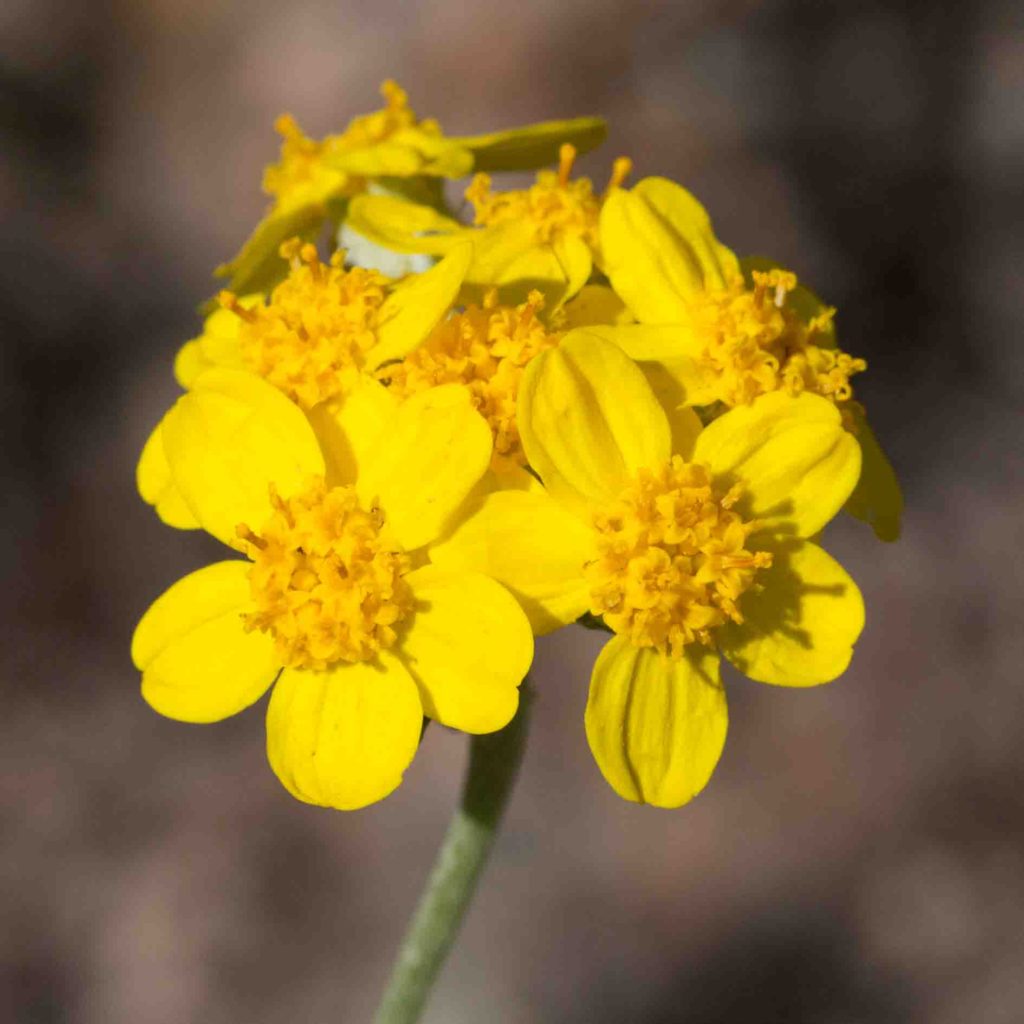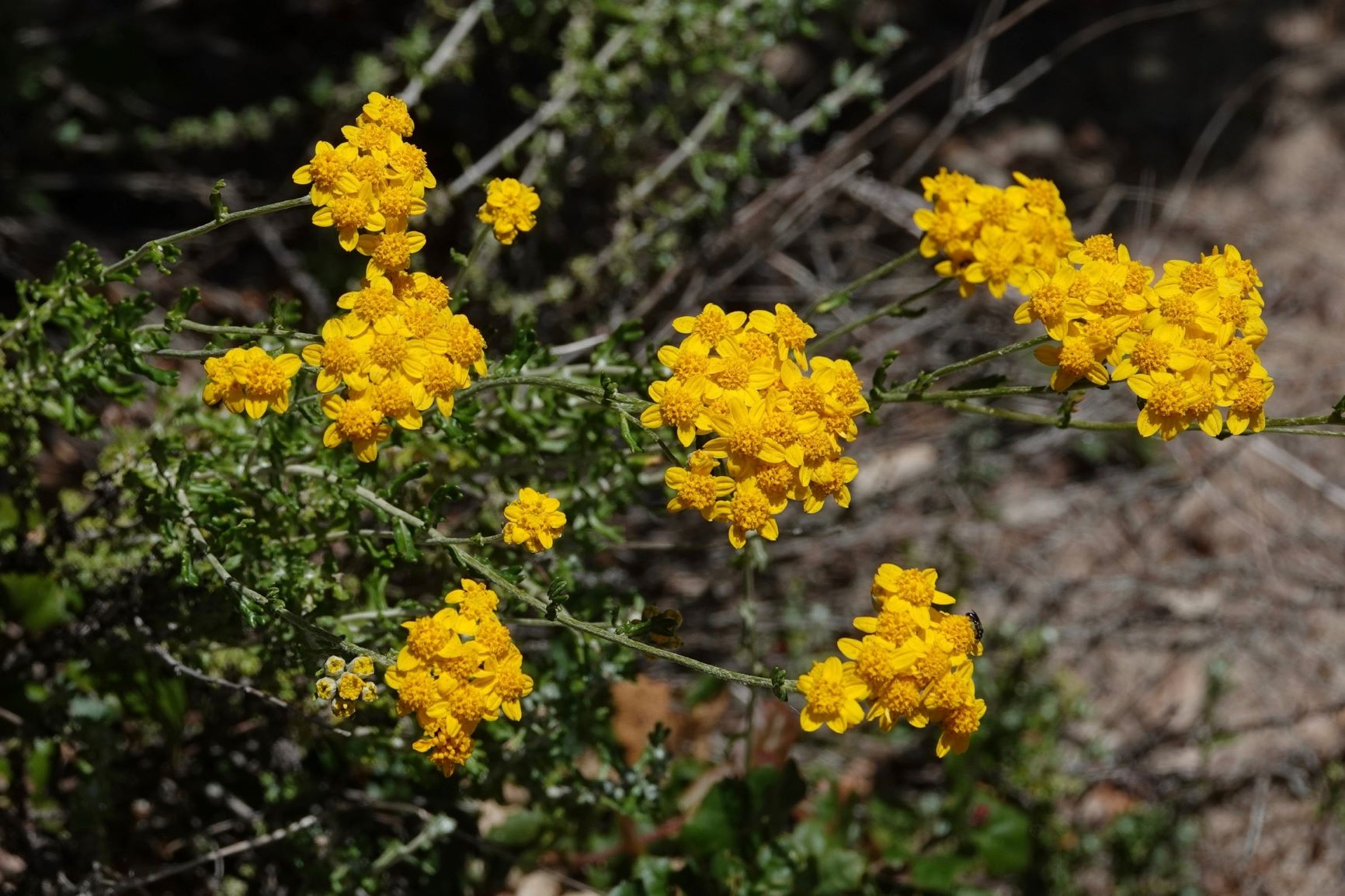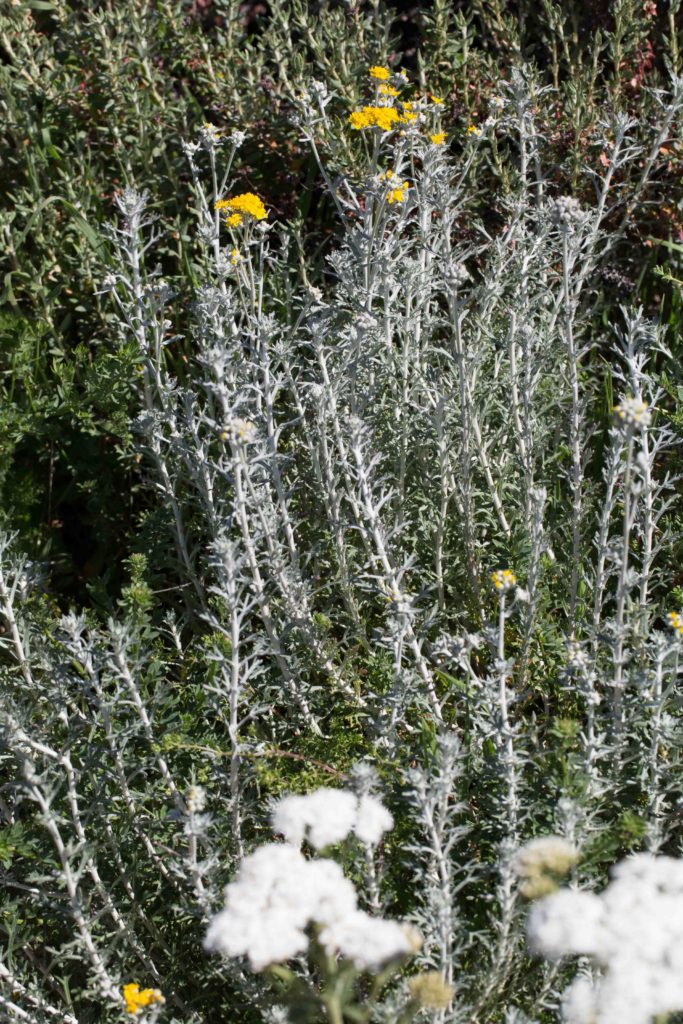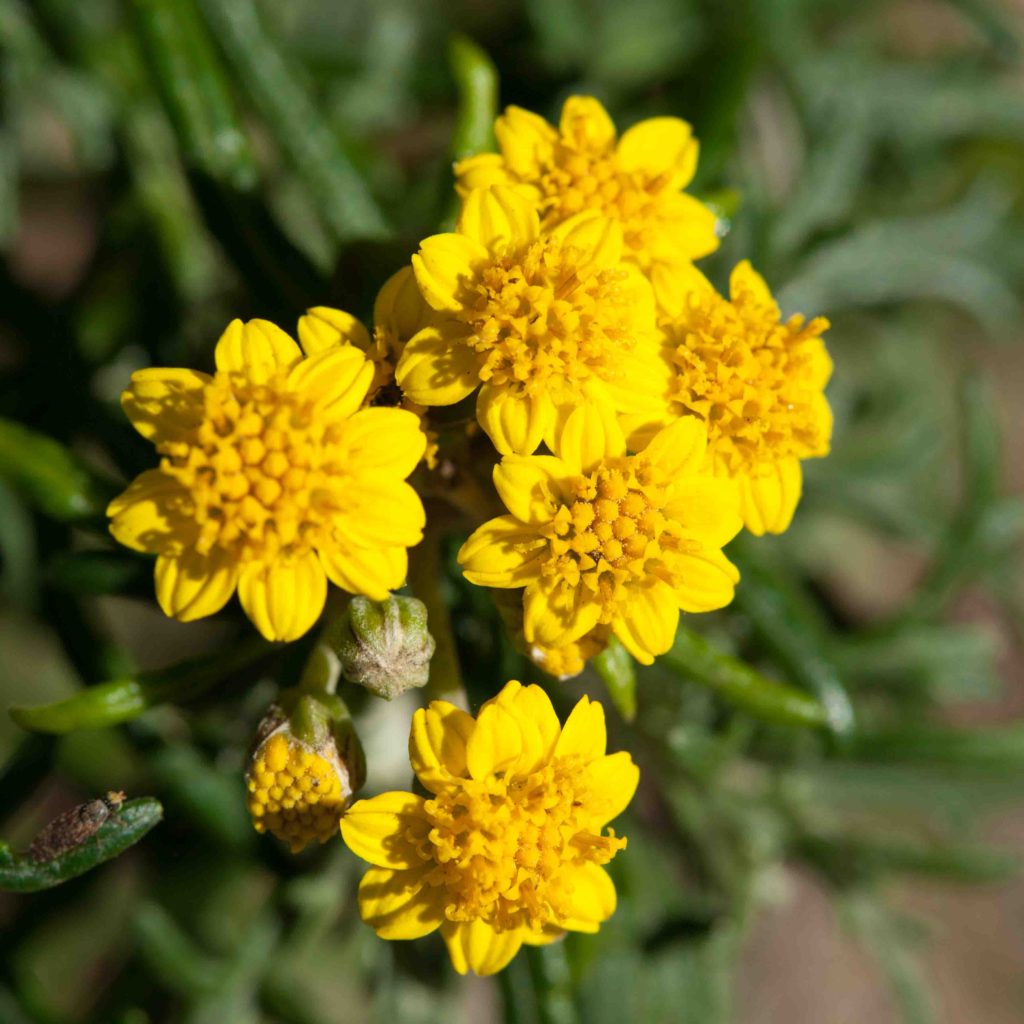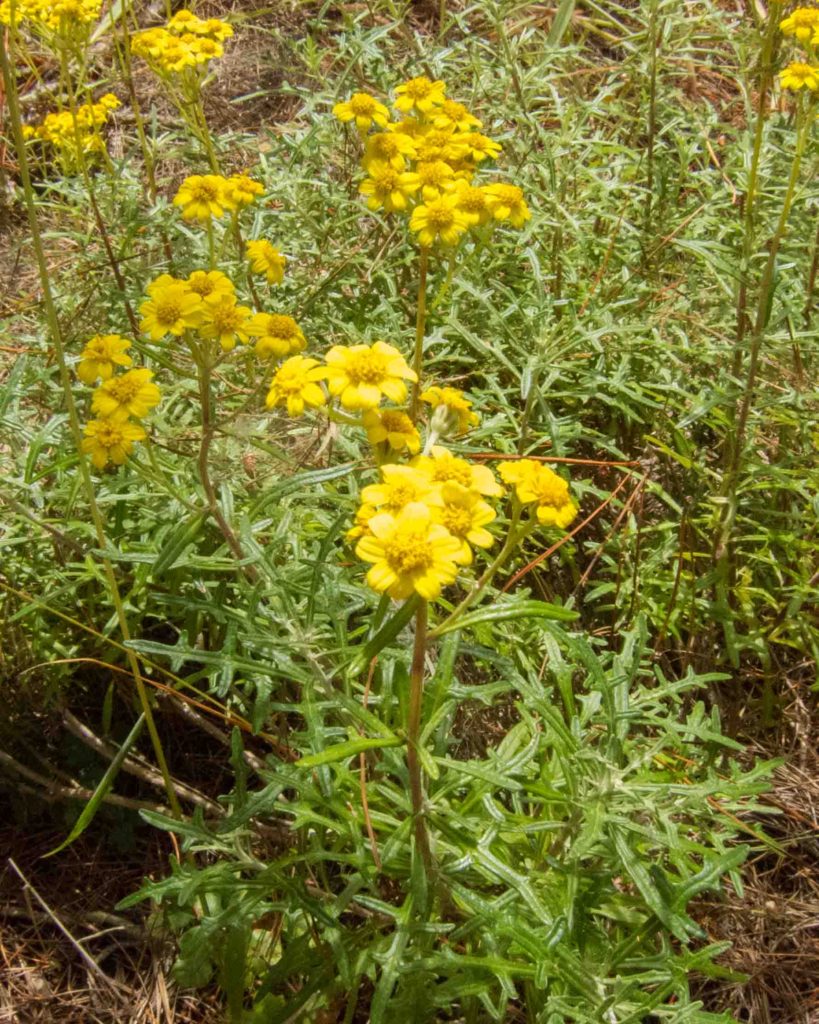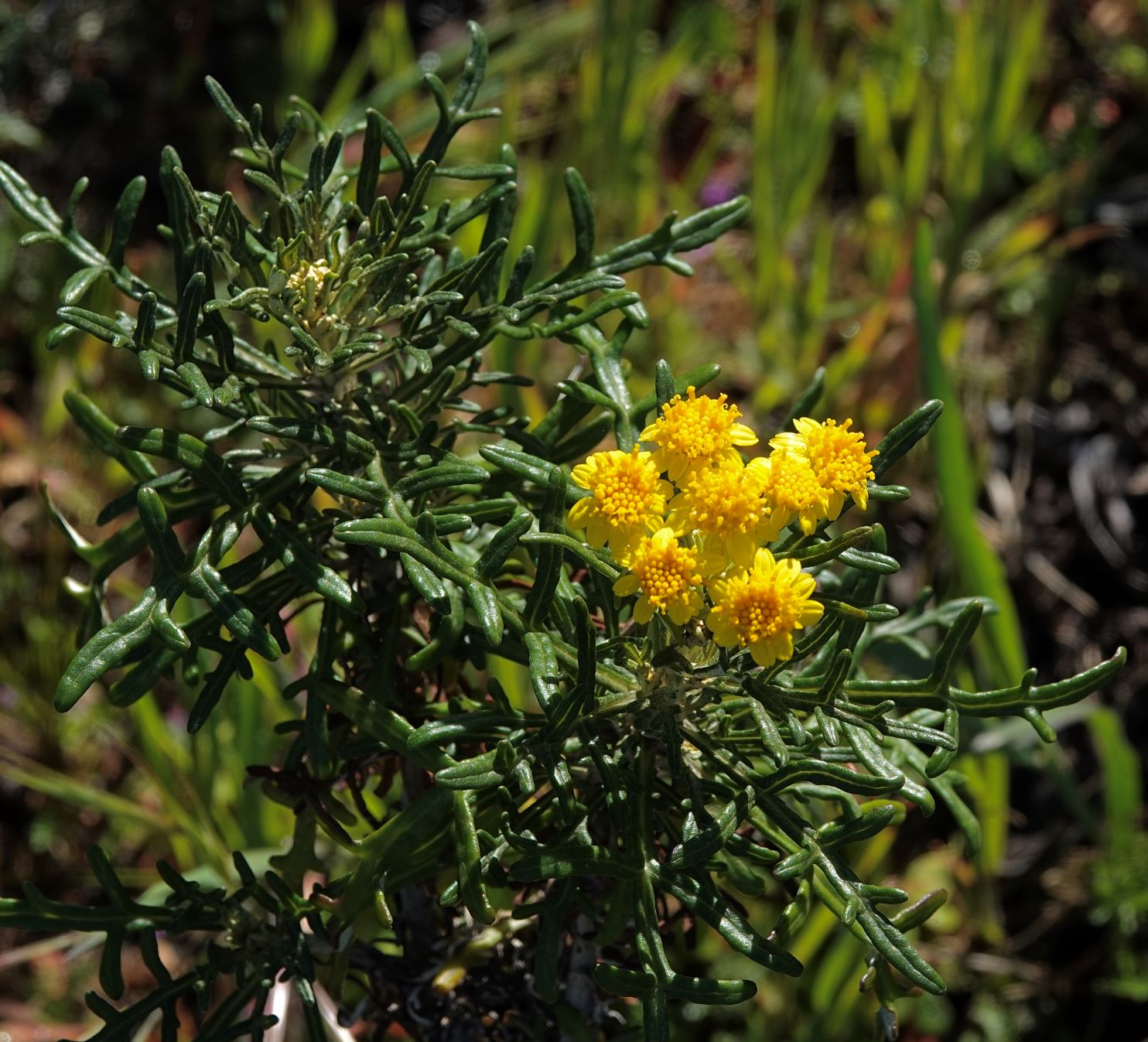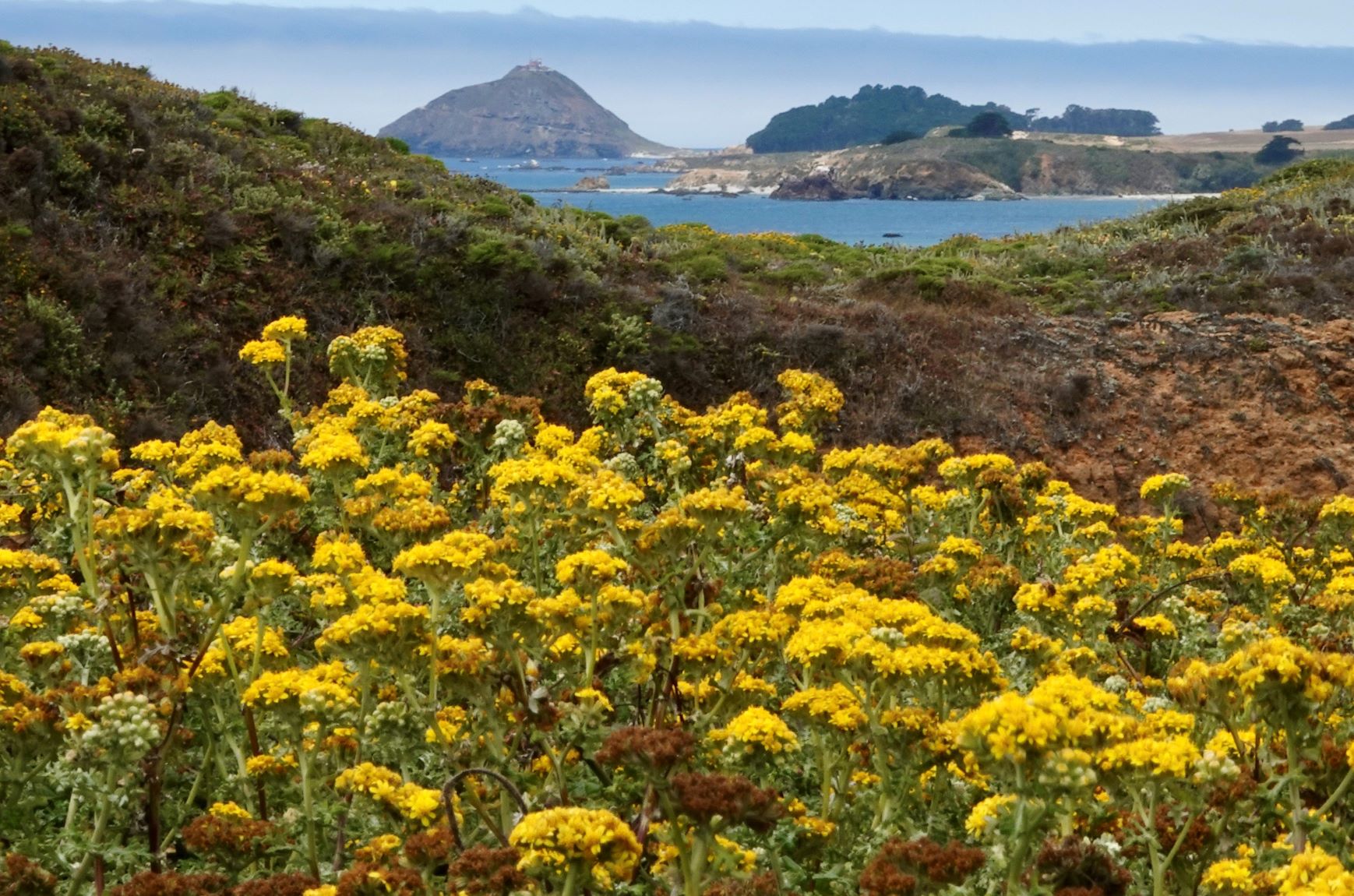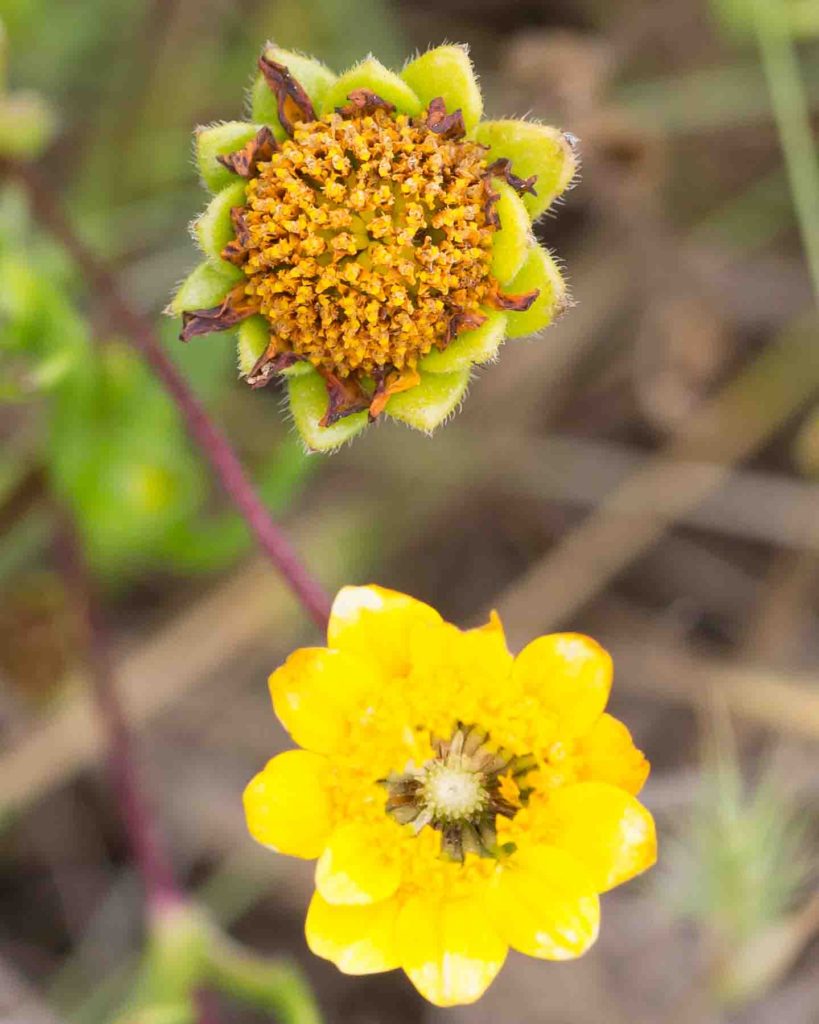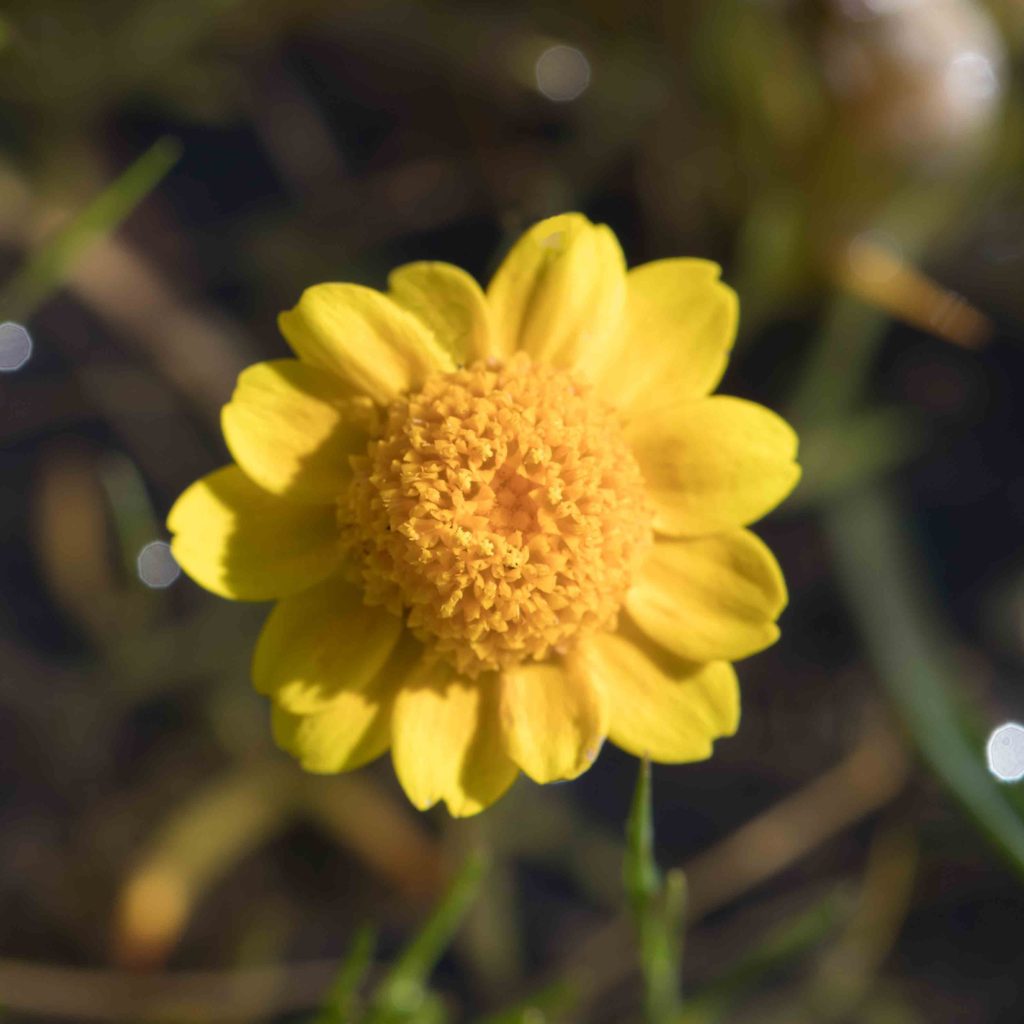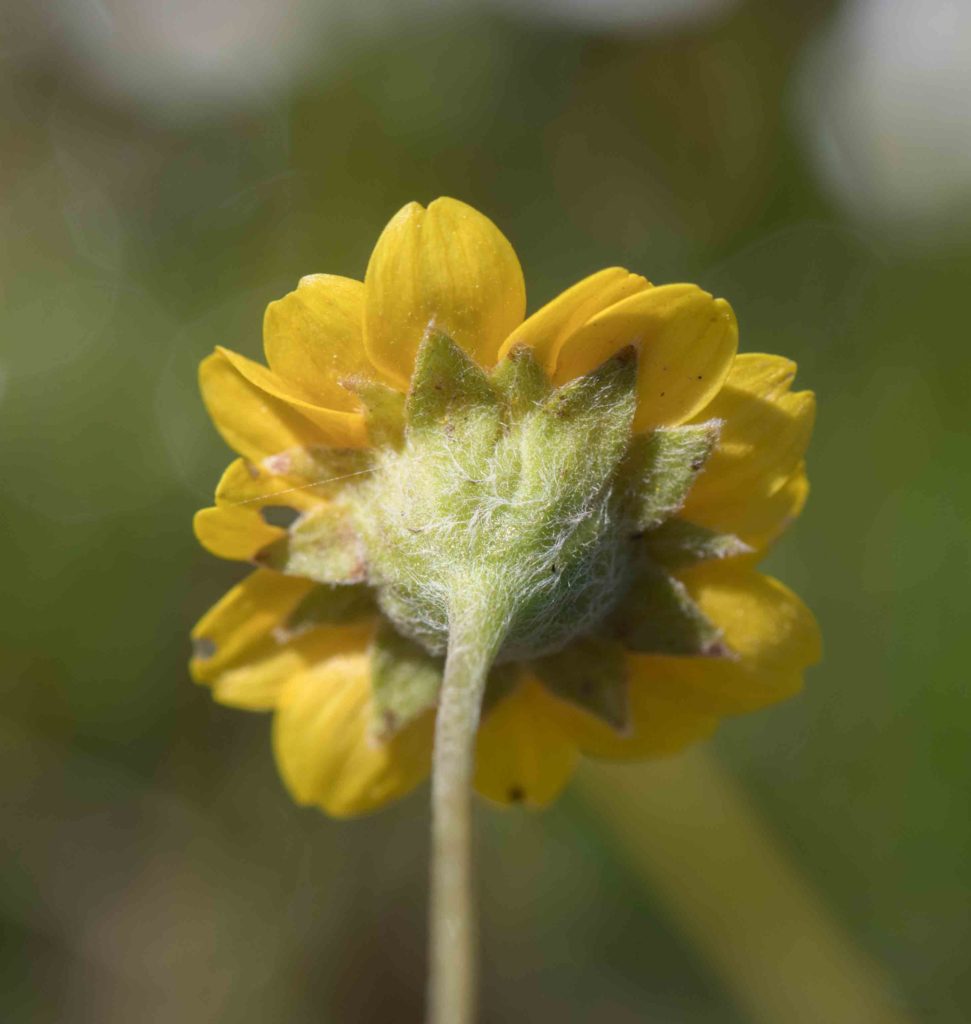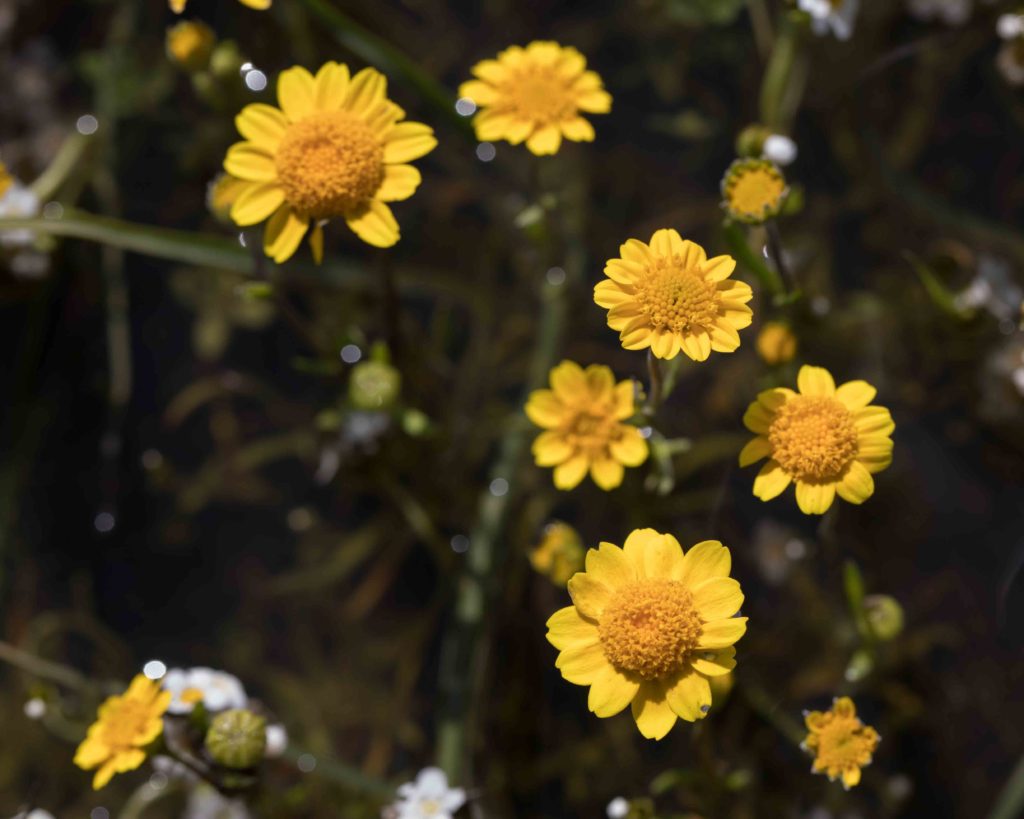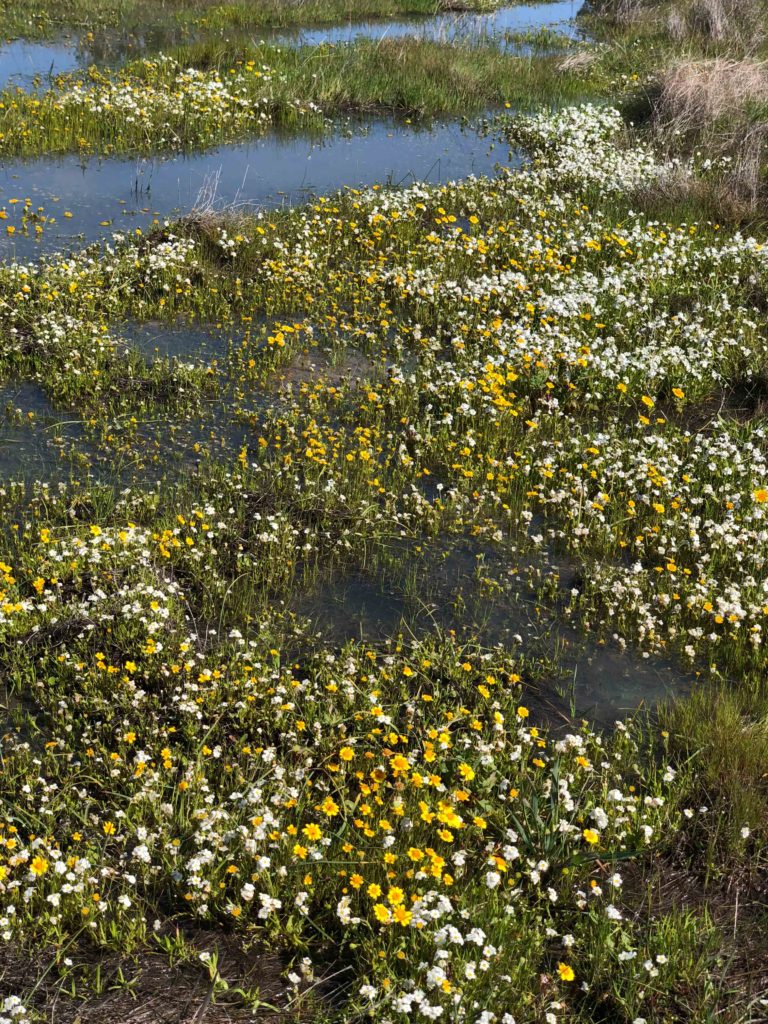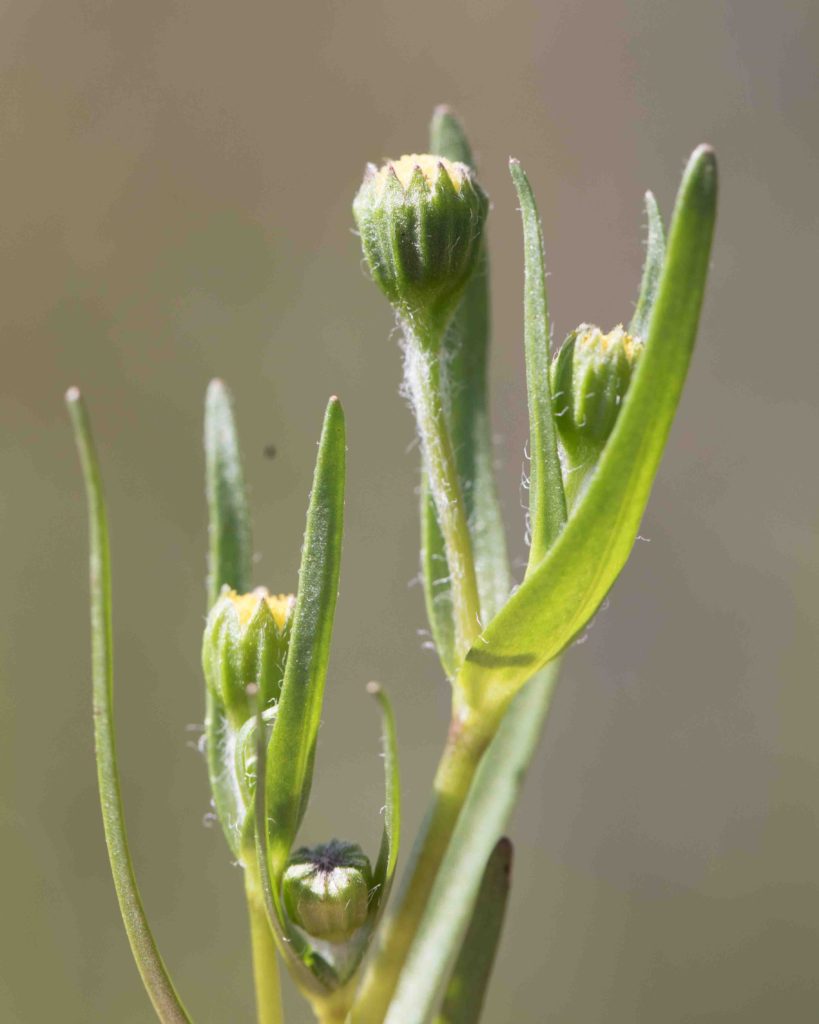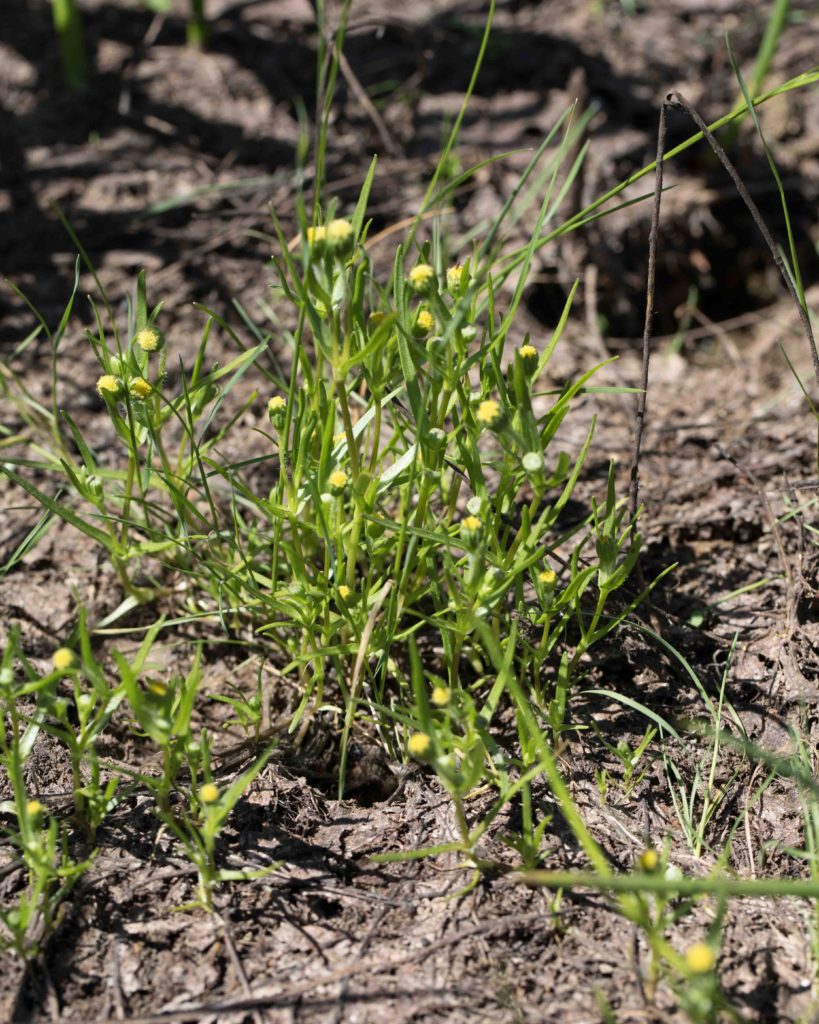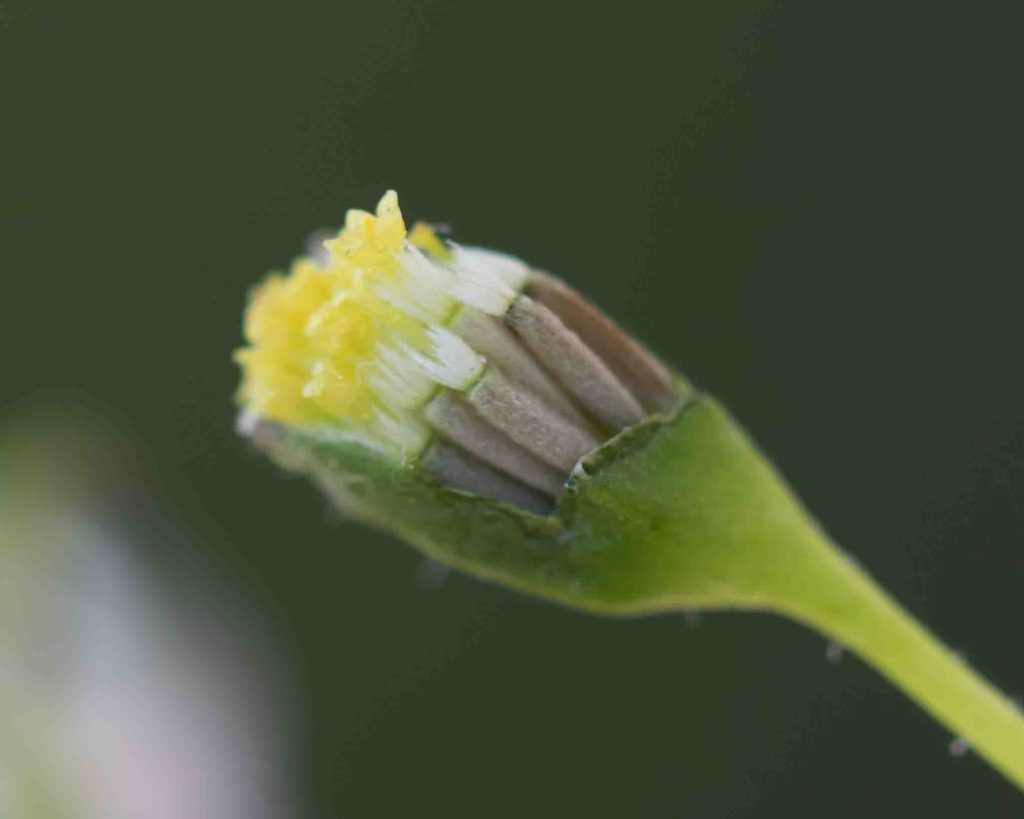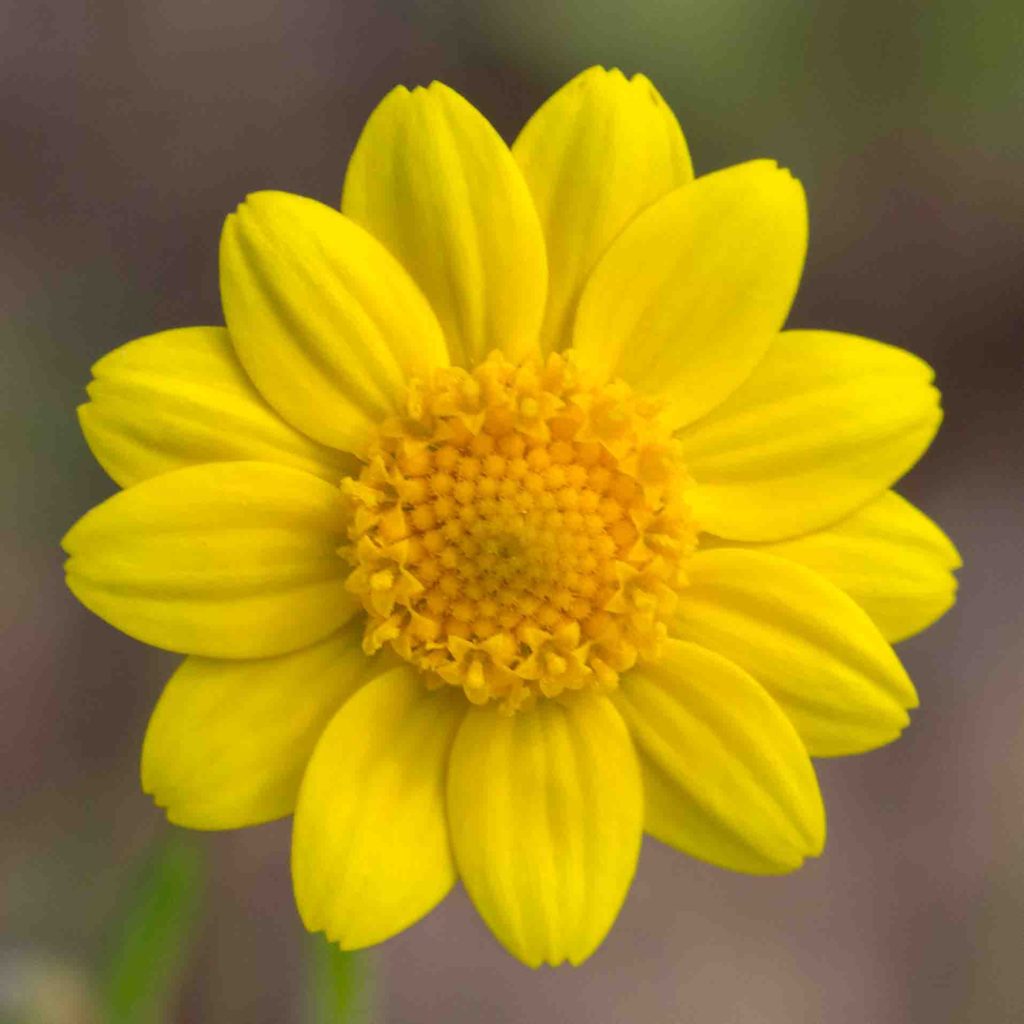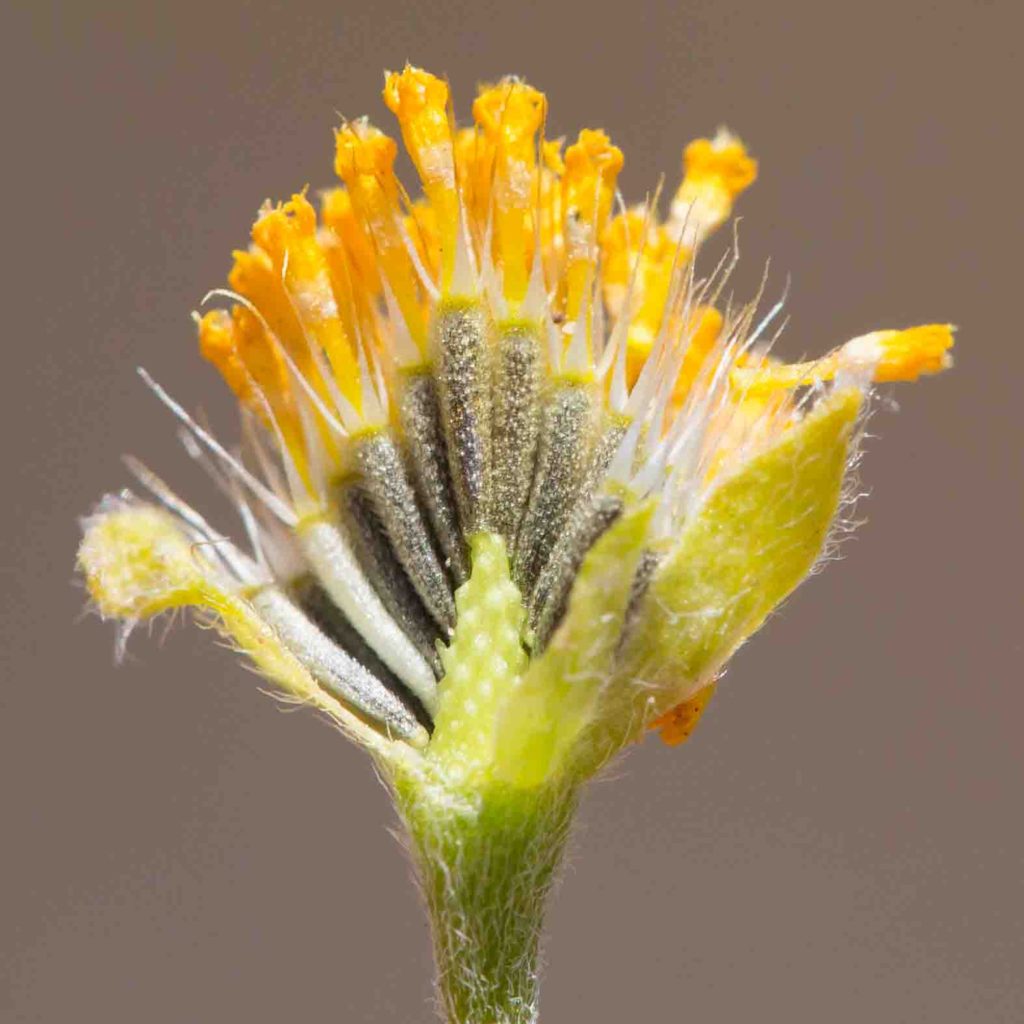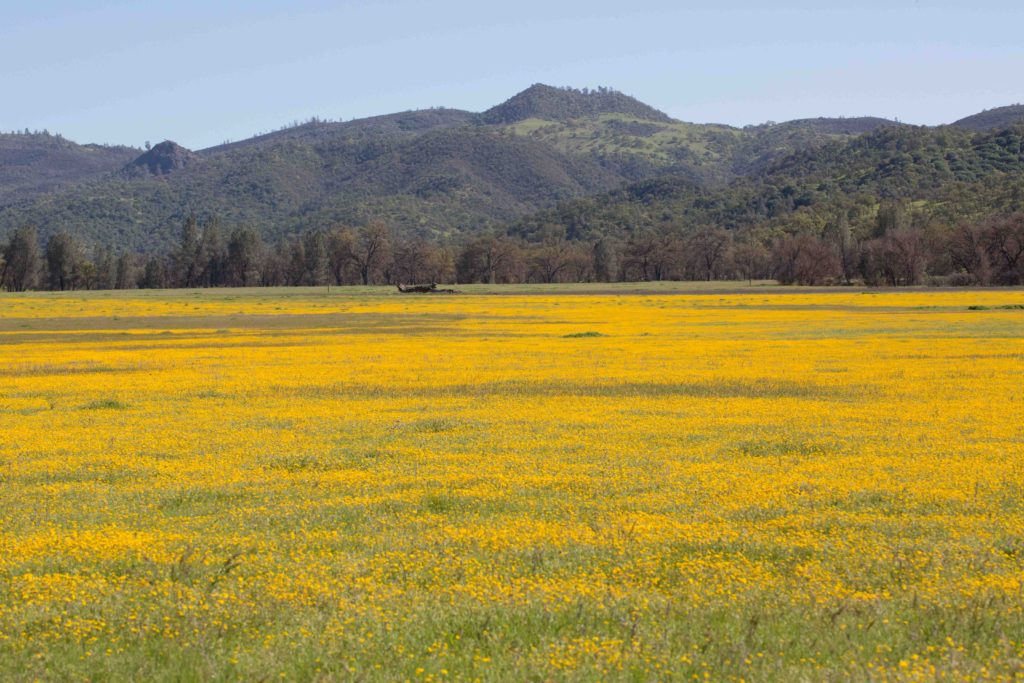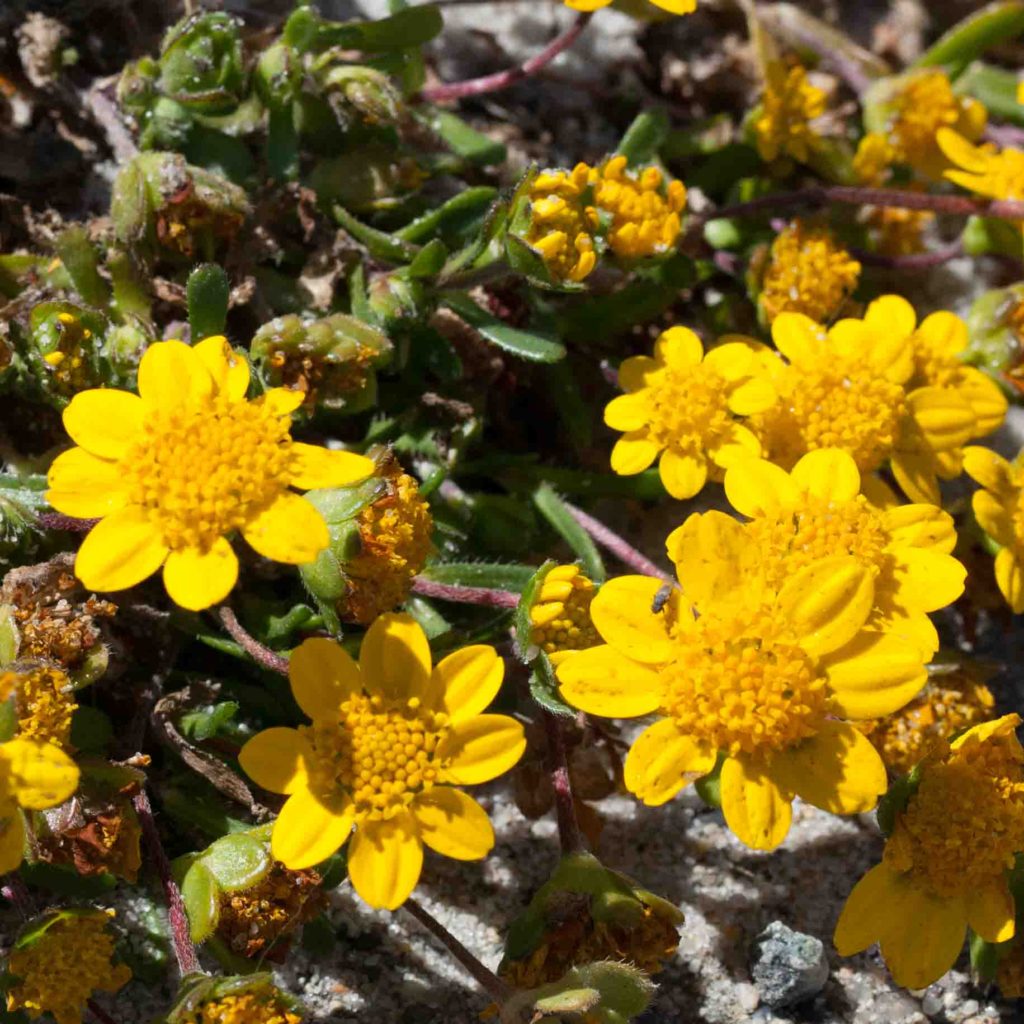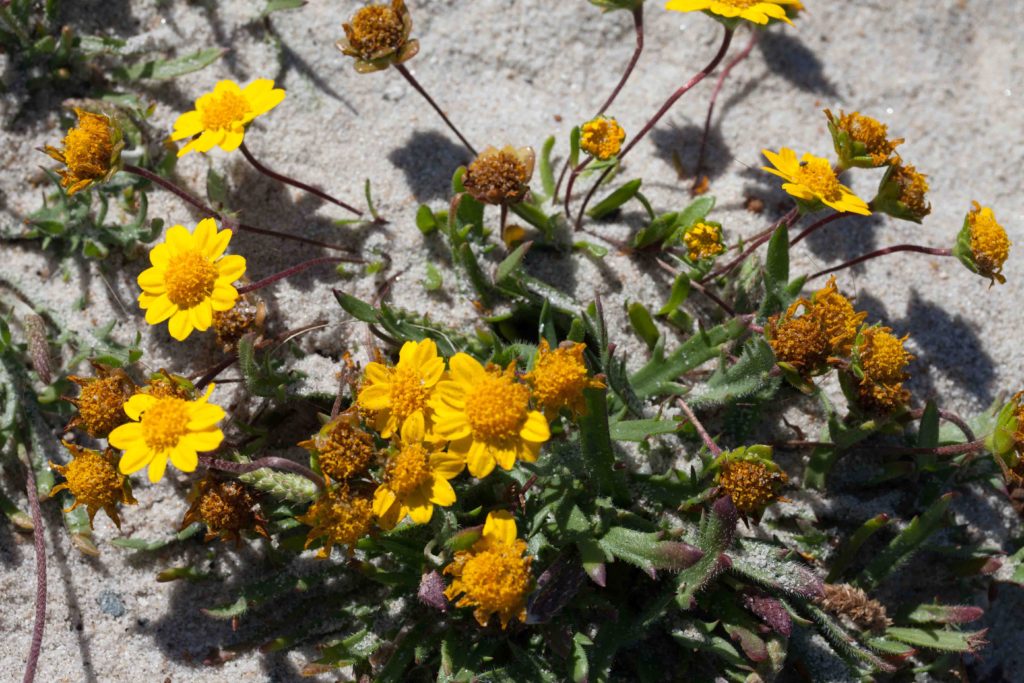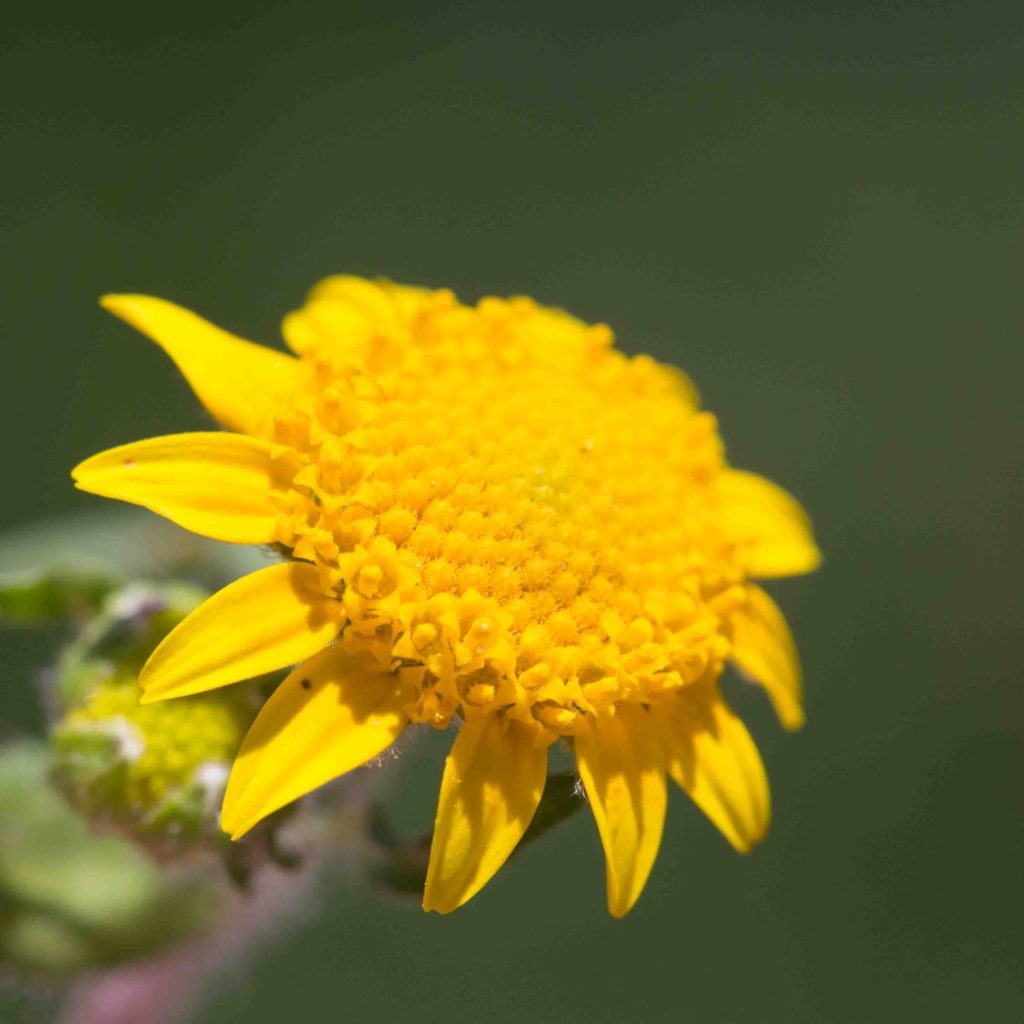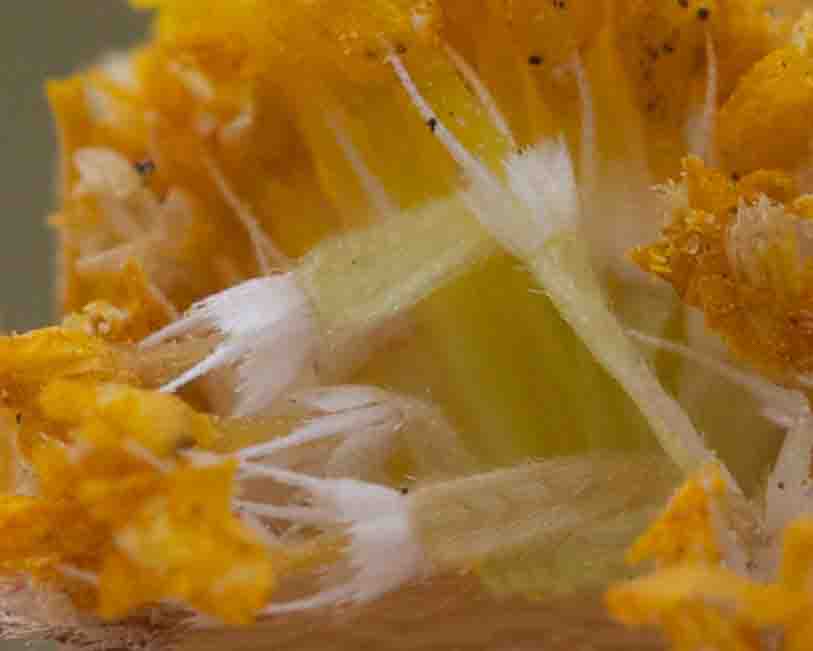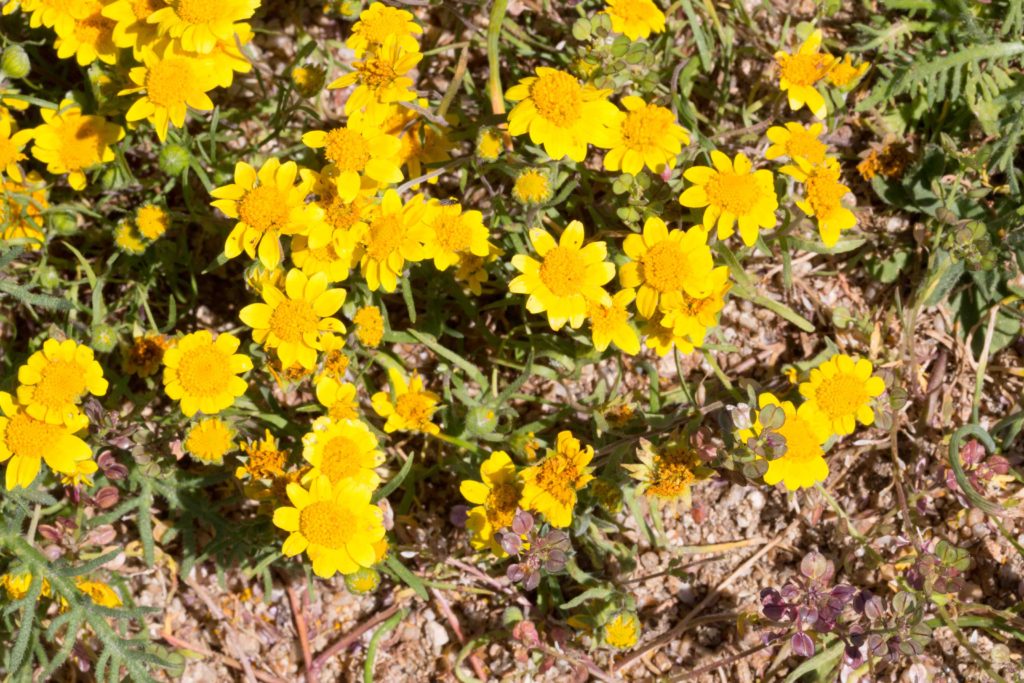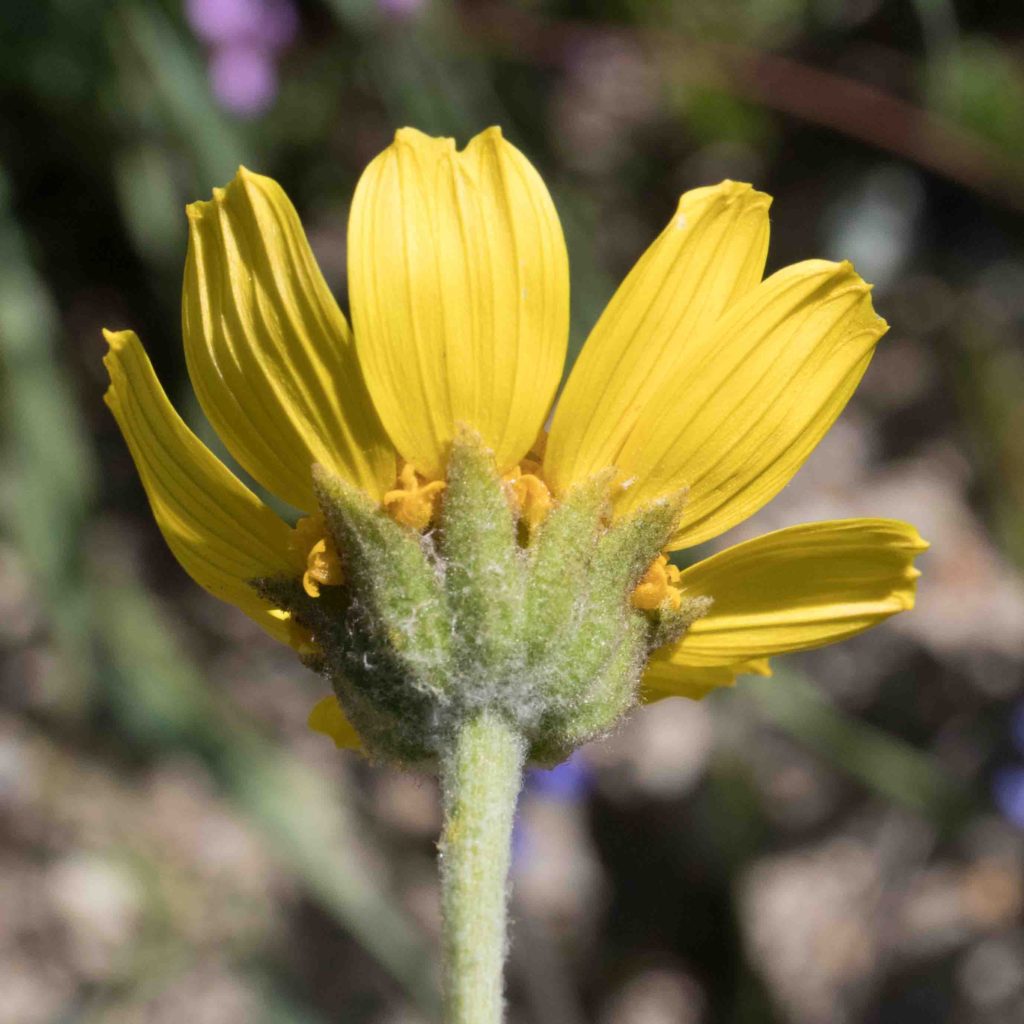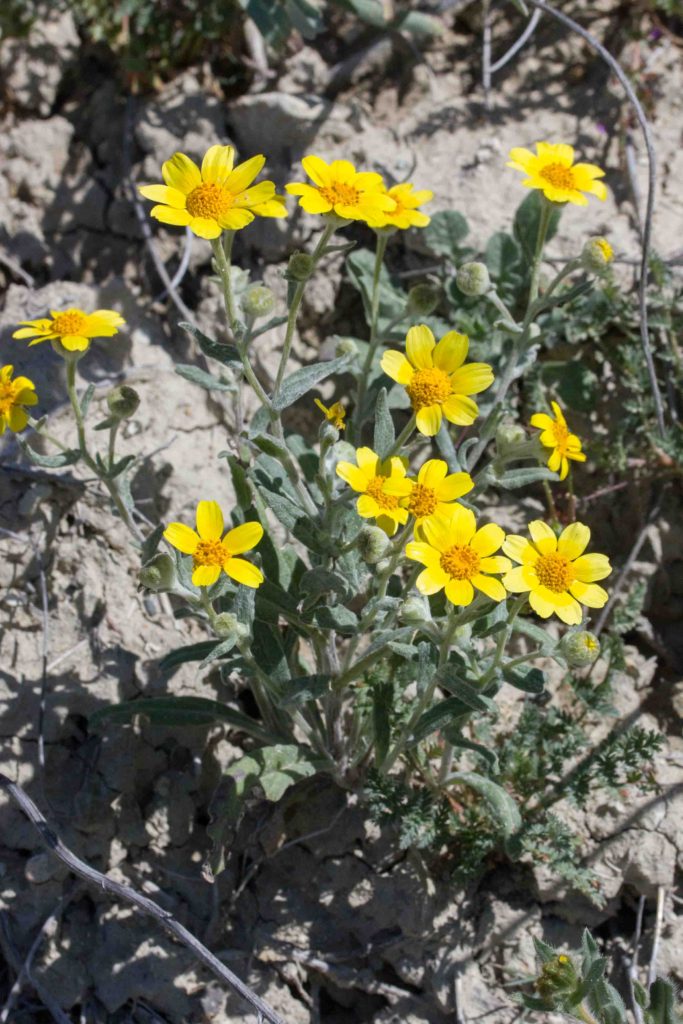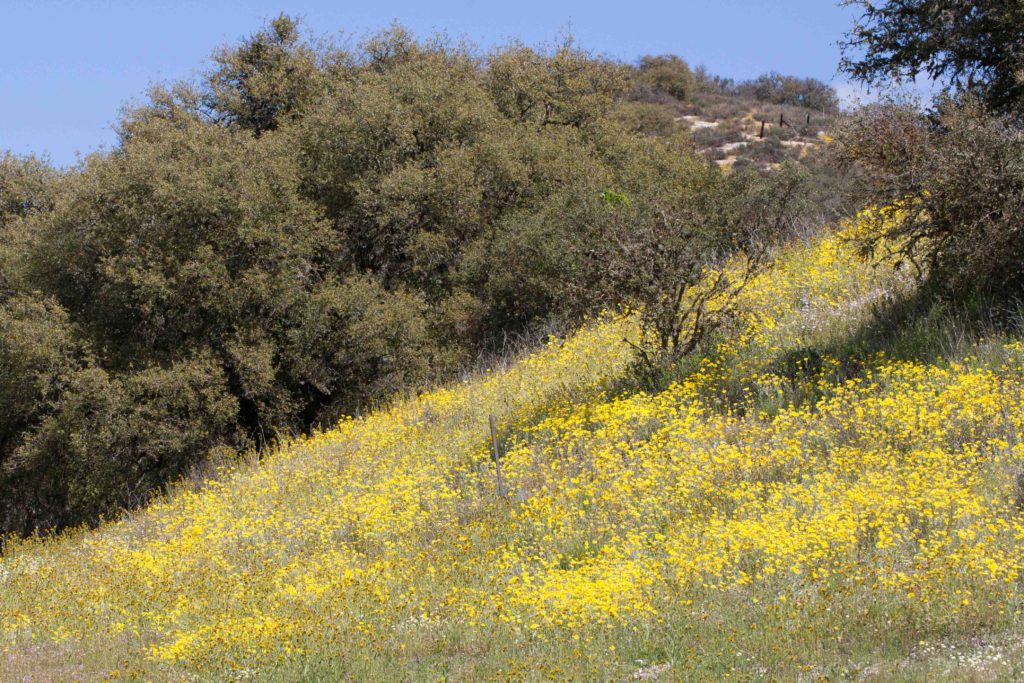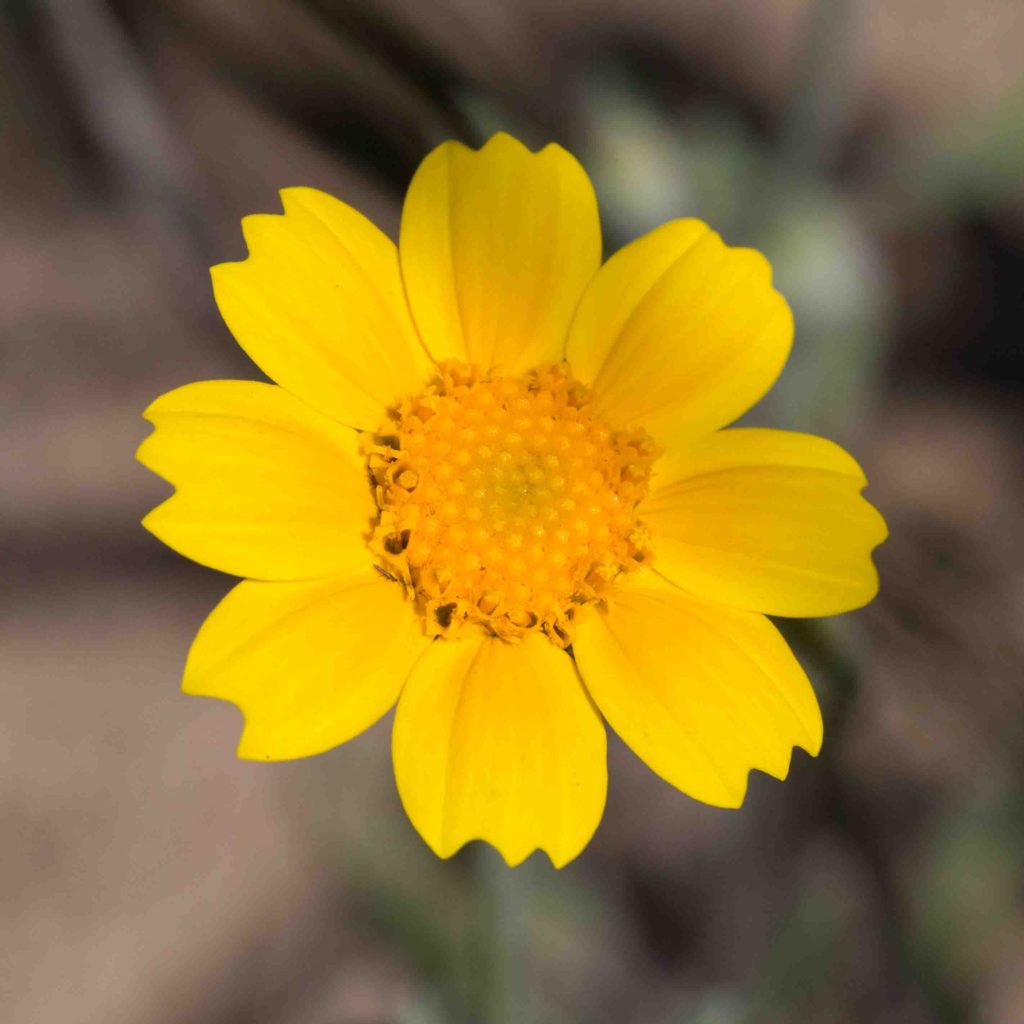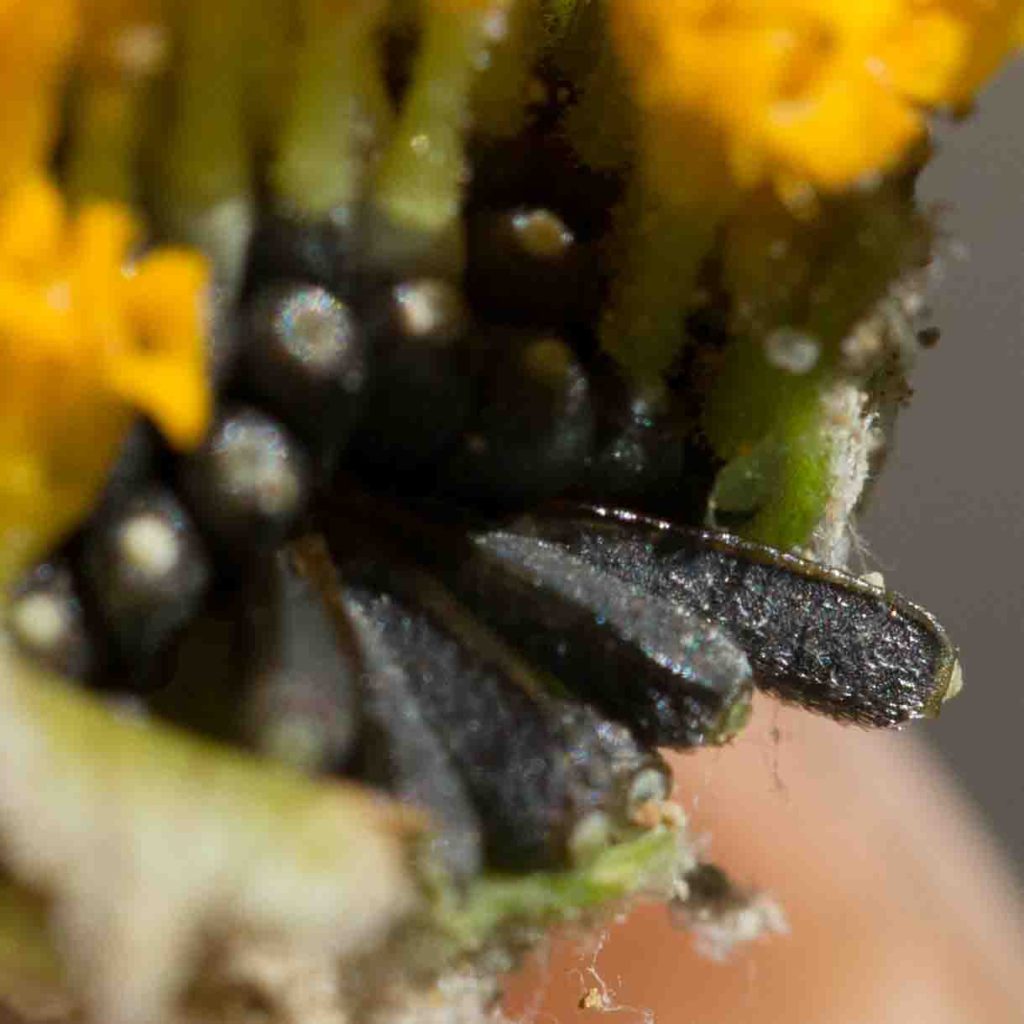Asteraceae: Sunflower Family – Heliantheae (Sunflower) Tribe: Goldfields
The Sunflower family is a very large family with over 25,000 members. Botanists subdivide the family into a number of tribes, of which 14 are present in Monterey County. One of these, the Heliantheae or Sunflower tribe, is further broken down into subtribes, of which 9 are present. This page covers the Goldfields subtribe. Lasthenia and Monolopia can cover whole hillsides in golden yellow (Lasthenia) or pale, lemon-yellow (Monolopia). The different Lasthenias can be difficult to identify without examining the pappus.
Golden Yarrow – Eriophyllum confertiflorum var. confertiflorum
Blooms:
Apr–Aug
Plant Height:
50–70 cm
Flower Size:
Small
Origin:
Native
Habitat:
Shrubby slopes, much more common inland than by coast
Notes:
A very common small shrub with its flowers at the end of long, branching peduncles. Easily confused with Lizard Tail (Eriophyllum staechadifolium, see below), but it has 4–7 strongly overlapping phyllaries and (usually) 4–6 ray flowers (as compared to 6–9 for Lizard Tail). Also, its leaves are smaller. It is more common inland, far less common near the coast. Despite the shared common name, it is unrelated to Common Yarrow (Achillea millefolium). Photo #2 by CJH.
Lizard Tail / Seaside Woolly Sunflower – Eriophyllum staechadifolium
Blooms:
Apr–Sept
Plant Height:
30–150 cm
Flower Size:
Small
Origin:
Native
Habitat:
Coastal
Notes:
Common by the coast where it grows in huge quantities. It has 8–12 scarcely overlapping phyllaries and 6–9 ray flowers, both of which serve to distinguish it from Golden Yarrow (Eriophyllum confertiflorum, see above). The common name derives from the shape of the leaf, which can resemble a short-tailed lizard. The genus name means woolly-leaved, referring to the near-white color of the leaves’ lower surface. Upper leaf surfaces are smooth green, with in-rolled margins. Photos #3-4 by CJH.
Perennial Goldfields – Lasthenia california subsp. macrantha
Blooms:
Mar–Apr
Plant Height:
< 40 cm
Flower Size:
Small
Origin:
Native
Habitat:
Grassland or dunes along immediate coast
Notes:
This species can be distinguished by its phyllaries (with 2 overlapping series), and by its fruits. The fruits are silver-gray, and may have between 0 and 4 awl-like pappus scales. Leaves are 3–9 cm long, narrow and paired.
Contra Costa Goldfields – Lasthenia conjugens
Blooms:
Mar–June
Plant Height:
< 40 cm
Flower Size:
Medium
Origin:
Native
Rare or Endangered?
Yes – 1.b1
Habitat:
Vernal pools and moist grassland
Notes:
A very rare goldfields, found in Monterey County only within Fort Ord. It can be distinguished partly by its habitat and partly by the number of its rather hairy phyllaries (12–18) and the fact they are fused for less than half of their length. It has 6–13 ray flowers. Leaves are linear and entire or occasionally pinnately lobed. It can be found locally in great numbers together with Hickman’s Popcornflower (Plagiobothrys chorisianus var. hickmanii), another rare plant.
Smooth Goldfields – Lasthenia glaberrima
Blooms:
Mar–July
Plant Height:
< 35 cm
Flower Size:
Very small
Origin:
Native
Habitat:
Wet meadows and mucky clay soils
Notes:
An unusual goldfields, partly by its liking for wet areas but more for its generally disciform heads. Tiny (< 2 mm) ray flowers may be present but generally are not, the 6–13 pistillate flowers having a style and stigma but no rays. The 5–10 phyllaries are fused about 2/3 of their length, have triangular tips and more or less surround the many disk flowers. Leaves are glabrous and linear in shape. Fruits have pappus scales—the only goldfields which has both fused phyllaries and pappus scales.
Common Goldfields – Lasthenia gracilis
Blooms:
Mar–May
Plant Height:
< 40 cm
Flower Size:
Medium
Origin:
Native
Habitat:
Open fields and hillsides
Notes:
The most commonly found Goldfields, noted for its ability to turn whole fields or hillsides a brilliant golden yellow. It is indistinguishable from California Goldfields (Lasthenia californica var. californica) except for the slightly different shapes of the pappus. In this species, the pappus is lance-ovate in shape and opaque white in color. There are 6–13 ray flowers and 4–13 free, hairy phyllaries.
Maritime Goldfields – Lasthenia maritima
Blooms:
May–June
Plant Height:
< 25 cm
Flower Size:
Very small
Origin:
Native
Habitat:
Seabird nesting sites along coast
Notes:
The stems are short and decumbent with fleshy leaves. The flower heads have 7–12 ray flowers, 1–3 mm long. The pappus has 4–12 brownish awns and 4–5+ narrow scales.
Coastal / Woolly Goldfields – Lasthenia minor
Blooms:
Mar–Apr
Plant Height:
< 35 cm
Flower Size:
Small
Origin:
Native
Habitat:
Grasslands near the coast, below 700 m
Notes:
This species is most readily identified by its pappus. This has 2–4 longer, tapered to lanceolate, brown or white awns, separated by a fringe of 4–5 shorter, fringe-like scales. No more than 13 ray flowers, 4–8 mm long. Phyllaries 7–14 and hairy at margins. The stem is sparsely to densely woolly.
Common Monolopia – Monolopia lanceolata
Blooms:
Feb–June
Plant Height:
5–80 cm
Flower Size:
Medium
Origin:
Native
Habitat:
Inland grassland, bare clay, chaparral & woodland
Notes:
A close relative of Goldfields (Lasthenia sp., see above), Monolopia can also cover hillsides with its bright yellow flowers. From a distance it appears more lemon- than golden-yellow. Individual heads have 3–10 ray flowers and 2–16 disk flowers. Leaves are alternate and gray-green. This is very similar to Cupped Monolopia (Monolopia major, see below). However, the phyllaries in this species are free or fused only about halfway (something that can be difficult to see because of the woolly hairs covering the involucre), and the fruits are uniformly gray with appressed hairs.
Cupped Monolopia – Monolopia major
Blooms:
Feb–July
Plant Height:
5–80 cm
Flower Size:
Medium
Origin:
Native
Habitat:
Inland, grassland or bare clay
Notes:
Very similar to Common Monolopia (Monolopia lanceolata, see above). In this plant, the phyllaries are fused to form a cup with triangular lobes, and the pappus is mostly glabrous, with hairs concentrated near the tip. Unlike Common Monolopia, this species is not generally found in chaparral or woodland.
